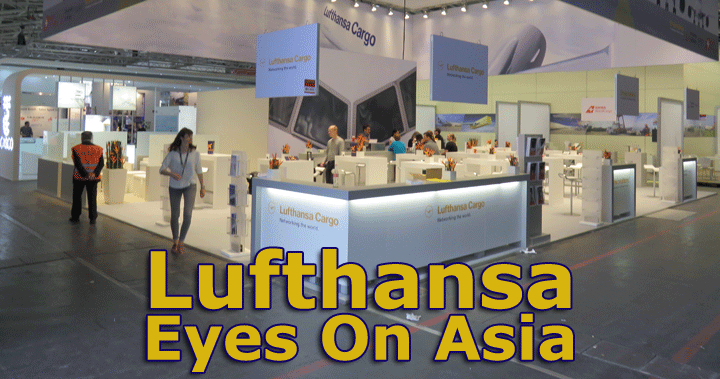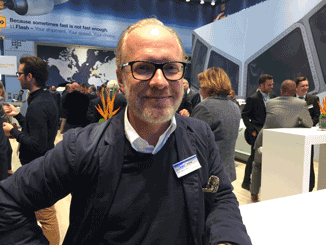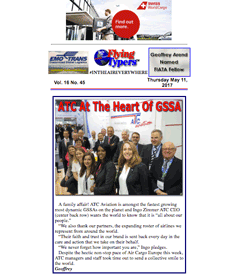
If
you found the recent Air Cargo
Europe a bit tight on breathing
room, you will get no argument
from us.
Just like many others, we spent
time earlier this month walking
the very narrow trade show aisles
at Messe Munich.
Last year, the aisles at TIACA
Paris (which probably could have
used more business) felt as wide
as runways.
It was just the opposite at ACE.
A complete sellout of booth space
delivered an aisle experience
that felt like navigating the
inside of a sardine can.
Air cargo went cheek to jowl in
Munich, Germany, inside an exhibition
hall with only two bathrooms (that
we could find) located near the
entrance.
 However, close quarters amongst
colleagues provided the opportunity
for plenty of face-to-face business.
On the bottom line, that is what
matters.
However, close quarters amongst
colleagues provided the opportunity
for plenty of face-to-face business.
On the bottom line, that is what
matters.
It just might be nice if trade
show organizers might work a bit
harder to deliver more space and
bathrooms.
Lufthansa Group’s large
exhibit extravaganza at the immediate
entrance was set up to include
all the German carrier's partners
and acquisitions.
The Lufthansa Group booth was
notable in its spread, which seemed
to stretch on into forever and
included scores of attendees eating
pretzels and soup throughout the
three-day event. It also boasted
the presence of Franz-Joseph Miller,
(left) the founder of time:matters,
the high-powered, high value shipping
service partnered with Lufthansa
Cargo.
FJ is packing it in after he sold
his stake to Lufthansa earlier
this year.
As FJ describes it, it’s
all nice-nice, but we wouldn’t
count this rather brilliant logistics
professional out of the industry
just yet as he retreats to his
thinking place.
Whilst passing on Lufthansa’s
canned press dinner in a Munich
basement, our ace reporter SkyKing
spoke to LCAG’s Director
South China, Hong Kong, and Taiwan
Konstantin Stathopoulos.
Loss
& The Light
By now, Lufthansa’s net
loss of €68m Q1 2017 compared
to an $8m loss a year earlier
is old news, but the performance
of the carrier’s logistics
division, which includes Lufthansa
Cargo, proved a shining light.
Europe’s leading cargo airline
earned €33m before interest
and tax, a turnaround performance
from the €19 loss booked
a year earlier.
A recovery in demand enabled a
year-on-year quarterly revenue
increase of 18.5 percent while
traffic, measured in revenue cargo
ton kilometers, expanded 6.3 percent
led by the Asia-Pacific region,
where net traffic revenue grew
19.8 percent year-on-year in Q1
to €218 million euros.
Hope
Springs Eternal
The positive results have encouraged
Lufthansa Cargo, which currently
services 300 destinations in 100
countries, to expand its freighter
flights to Shanghai from the current
seven per week to nine in September.
Guangzhou will also see more capacity,
up from the current four freighters
per week to five starting in July.

Asian
Demand Up
Konstantin Stathopoulos told FlyingTypers Asian demand had been positive
throughout the first quarter with
China (including Taiwan and Hong
Kong) a top performer both before
and after Chinese New Year and
on both inbound and outbound lanes.
“The peak season at the
end of last year was definitely
higher than we expected,”
he said. “We always experience
good demand in the fourth quarter
from October, but last year it
was bigger than expected and we
didn’t really see a cut-off
of demand over the Christmas and
New Year holidays.
“That made a very nice ramp
going into this year.
“We saw very good demand
before CNY and then March and
April were also very good in both
directions in and outbound China.”
Varying
Factors Driving Growth
Stathopoulos said a number of
factors explained the prolonged
boost in demand. “On some
lanes, not least from Europe to
Asia and more recently ex-China,”
he said, “port congestion
had contributed to modal shift.
“The Hanjin bankruptcy last
year definitely played into it
and the sea carriers overall reduced
their capacities,” he explained.
“This led to a reduction
in stocks in the warehouses in
Europe and the U.S. that needed
to be refilled quickly. As well
as product launches, we had the
recall of the Samsung phones and
quite firm management by Chinese
authorities on extra capacity
going out of Chinese airports.
“Many airports are very,
very restricted for chartered
flights but as a line operator
you have the advantage to add
capacity in these markets, whereas
the pure charter operators can’t.
“All of that combined led
to the extraordinary peak we saw
last year and also then into the
first half this year,” he
declared.
New
Normal At Hand
Konstantin believes higher demand
to and from key Asian markets
could represent a ‘new normal,’
at least for 2017 and possibly
beyond.
“This is a trend that has
been evident for quite some time
now—that the demand ratio
in and outbound China is actually
quite balanced from an airfreight
point of view,” he said.
“There are definitely more
and more imports as the government
encourages domestic consumption.
“And exports are up this
year,” he said.
China
Never Went Away
“You can’t say that
the Chinese economy is recovering,”
Mr. Stathopoulos said, “because
it was never really in a bad situation.
“But certainly this negative
trend of decreasing growth rates
has changed from our perspective
and, given the right environment,
this will continue for the remainder
of the year, which is why we’ve
expanded our freight services
into our existing gateways at
Shanghai and Guangzhou, hubs where
we have seen positive developments.”
Healthy
Balances
“The most important part
for us is to have a healthy loads
on our aircraft, in and outgoing.
“There are not many markets
in the world which have a healthy
balance so this helps us have
a good profitable operation and,
on the other side, of course as
soon as the demand is high enough,
it gives us more room to work
on the revenues, on profitability
and on rates.
“In China, we have seen
rates increase. It’s not
huge but it’s certainly
a few percentage points.”
Look
Up To See Down?
“I think the interesting
phase will now come over the summer
months—the traditional low
season.
“The question really is
how far down do rates have to
go, and can we still keep that
gap of positive growth in terms
of rates towards last year as
well?”
HKIA
“Shì de, qing”
“Yes, please,” HKIA
remains a key part of Lufthansa
Cargo’s Asia strategy.
The carrier has now moved
its ground handling operation
at the world’s largest freight
hub to Cathay Pacific Cargo Terminal
(CPCT), cementing the joint business
agreement signed with Cathay Pacific
Cargo last year that sees the
two airlines work closely on network
planning, sales, IT and service
enhancements as well as now sharing
a single location for export drop-off
and import delivery.
“HKIA certainly remains
one of most important hubs in
our network in Asia,” said
Stathopoulos.
“If you look at the development
of HKIA overall as an air cargo
port, it is still growing.
“Certainly not with big
growth rates as you can see in
Mainland China cities, but it’s
still growing.
“In the future we still
see HKIA as the main gateway in
southern China. Obviously, what
we want to reach is the market
position and also a position in
front of our customers that makes
us indispensable for them and
gives us more growth opportunities
jointly together with Cathay.
Cathay as local carrier has different
opportunities here than we have.
We think, as two big global cargo
companies, we can definitely achieve
more here than we could achieve
individually.”
Look
Up To See Down?
As to the future, it belongs to
Asia.
“We see a positive drive
for exports, especially into Europe
but also into the U.S. and other
markets,” said Stathopoulos.
“One of our biggest benefits
is we’ve established ourselves
as the quality carrier in these
markets with only very little
changes and customers do appreciate
and see the value of our very
reliable service.
“A lot of carriers have
withdrawn services, or withdrawn
completely from the freighter
market, so it really shines in
the market that we’ve been
very reliable and that our services
are there to stay in our market.”
SkyKing |





